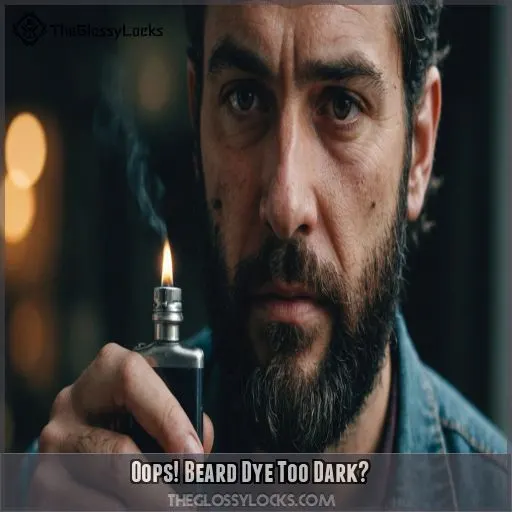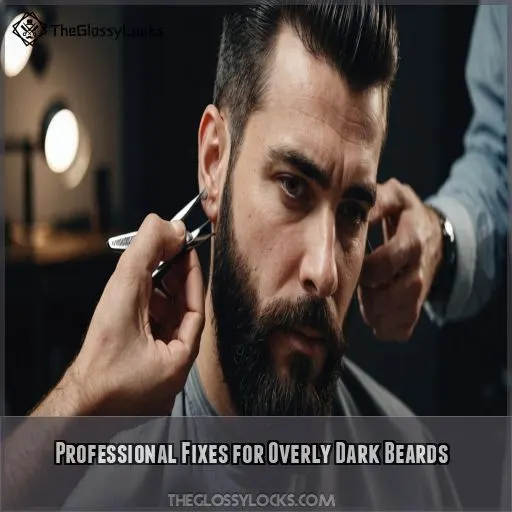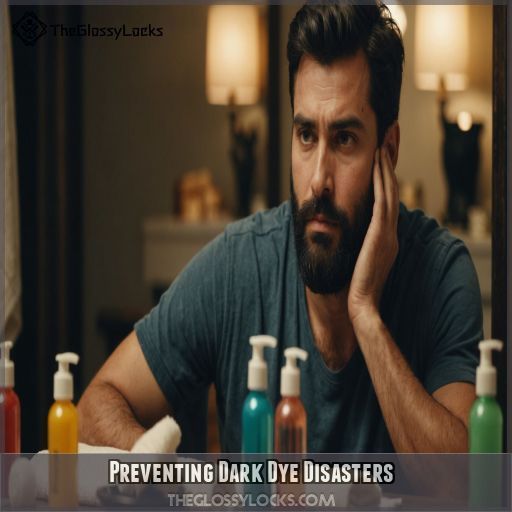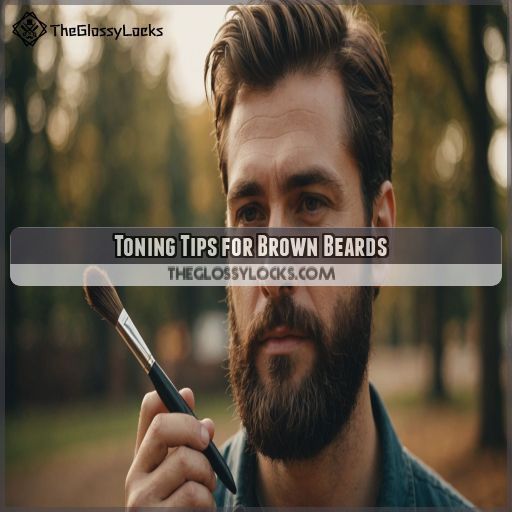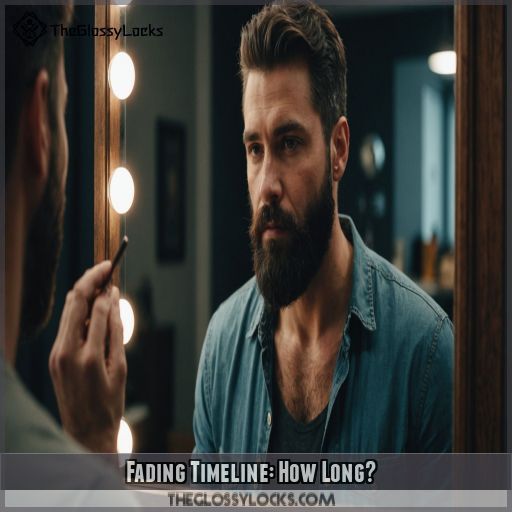This site is supported by our readers. We may earn a commission, at no cost to you, if you purchase through links.
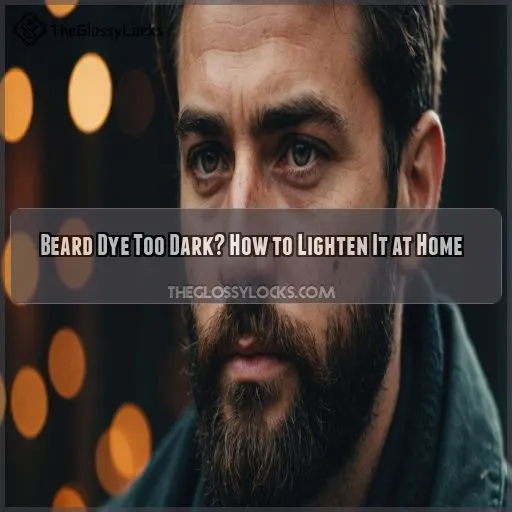 You’re rocking a beard, but the color is giving… red stripes. Don’t worry, it happens to the best of us.
You’re rocking a beard, but the color is giving… red stripes. Don’t worry, it happens to the best of us.
If you’re wondering how to lighten dark beard dye, the good news is there are fixes at home and in the pros’ hands.
Try a baking soda and lemon juice paste, an apple cider vinegar rinse, or a vitamin C tablet treatment to lighten it up.
If that doesn’t do the trick, consider clarifying shampoo or a hair lightener.
On the other hand, if you’re not ready to take control in the shower, consult a stylist – they’ll help you find your perfect shade.
Table Of Contents
- Key Takeaways
- Oops! Beard Dye Too Dark?
- DIY Solutions to Lighten Up
- Professional Fixes for Overly Dark Beards
- Patience is a Virtue: Waiting for Fade
- Post-Dye Care: Treating Your Beard
- Preventing Dark Dye Disasters
- Toning Tips for Brown Beards
- Fading Timeline: How Long?
- Next Steps: Embrace the Fade
- Frequently Asked Questions (FAQs)
- What to do when you dye your beard too dark?
- How do I lighten my hair after I dyed it too dark?
- How to make beard dye fade fast?
- How to make beard color lighter?
- How does beard dye interact with skin dyes or allergic reactions?
- Are there any long-term effects of using bleach on beard hair?
- Can you achieve subtler results with temporary or semi-permanent dye?
- Whats the best method to prevent ingrown hairs after dye removal?
- Does beard oil or balm help to maintain color vibrancy longer?
- Conclusion
Key Takeaways
- We’ve all been there – you dye your beard too dark and it’s a total bummer! Don’t stress, there are ways to fix it. Try using a DIY solution like a baking soda and lemon juice paste or an apple cider vinegar rinse to gently lift the color.
- If the DIY solutions don’t work, consider visiting a professional stylist who can customize a solution for you. They’ll help you find your perfect shade and make sure your beard looks its best.
- To extend the life of your beard dye, use a color-safe shampoo, avoid heavy styling products and heat styling tools, and wash your beard every 2-3 days. This will help prevent fading and keep your beard looking healthy and vibrant.
- If you’re dealing with ingrown hairs or skin sensitivity after dyeing your beard, try exfoliating gently with a warm washcloth and sugar scrub 1-2 times a week. Also, clean the dye area thoroughly with soap and water post-dyeing to prevent any irritation.
Oops! Beard Dye Too Dark?
We’ve all been there. You go in for a quick beard touch-up, and suddenly, you’re rocking a shade that’s more suited for a Gothic rock band than your everyday look.
Don’t panic! Whether you went a tad too heavy-handed with the dye or chose a color that turned out darker than expected, there are several ways to fix your overly darkened beard.
From quick DIY fixes to professional color correction, you can restore your beard to a more desirable shade without resorting to drastic measures (like shaving it all off).
DIY Solutions to Lighten Up
So, your beard dye job went awry, and now you’re rocking a darker look than you bargained for. Don’t stress; we’ve some simple DIY fixes to lighten things up.
Baking Soda and Lemon Juice Paste
If your beard dye turned out too dark, you can lighten It at Home with a simple paste made from baking soda and lemon juice. This natural remedy is an effective and cheap solution. However, you should keep this in mind: lemon juice works best for those with lighter hair colors, and it may not produce noticeable results for darker hair.
To make the paste, simply mix equal parts baking soda and lemon juice. Apply the paste to your beard and let it sit for about 45 minutes before rinsing with warm water. While this method is generally safe, baking soda can have a drying effect, so be sure to follow up with a good conditioner to keep your beard healthy and hydrated.
Apple Cider Vinegar Rinse
Time for a change-up from baking soda! Now, let’s get to the Apple Cider Vinegar Rinse. Mix equal parts apple cider vinegar and water in a spray bottle. Apply to damp hair and let it sit for 20 minutes, then rinse with cool water. Here are three benefits of this DIY solution:
-
- Strips impurities and removes excess dye residue
-
- Helps to even out color tone
-
- Leaves your beard healthy, shiny, and smelling great
Vitamin C Tablet Treatment
| Crushed vitamin C tablets are a surprising fix for overly dark beard dye. Mix a crushed tablet with your shampoo and apply to wet hair for an hour. Rinse with cold water, and you may see up to 2 shades of lightening. That’s a small price to pay for a quick fix, right? | Treatment | Procedure | Time | Shades |
|---|---|---|---|---|
| Vitamin C + Shampoo | Mix crushed tablet, apply to wet hair | 1 hour | Up to 2 shades | |
| Wait | Rinse with cold water | |||
| Repeat | For desired shade | Ongoing |
Clarifying Shampoo
Clarifying shampoo can be a lifesaver when your beard dye is too dark. Here’s how you can use it to lighten your beard at home:
- Wet your beard and apply a clarifying shampoo.
- Leave it on for a few minutes to allow it to work its magic.
- Repeat the process until your beard reaches the desired shade.
- Follow up with a moisturizing treatment to prevent dryness sealing moisture in hair.
.
This DIY solution is a gentle and effective way to correct common hair dye mistakes and achieve a more natural look.
Blue or Purple Shampoo
You’ve tried clarifying shampoo to brighten up your beard, but still, the color is too dark. Now, it’s time to try some DIY toning solutions! Reach for a blue or purple shampoo, which can help counteract the warm tones in your beard dye blue vs purple shampoo.
, which can help counteract the warm tones in your beard dye. Apply it to your beard, let it sit for 5-10 minutes, and then rinse with cool water.
Professional Fixes for Overly Dark Beards
If you’ve applied beard dye that’s too dark, you’re not alone.
There are solutions that can help lighten it up, and still look like a pro did it.
You can either try a few professional fixes or opt for a professional stylist to assess and suggest the best course of action to achieve the desired color and texture for your beard.
Bleed the Color Out
If "DIY solutions" aren’t yielding the desired results, it’s time to bust out the pro-grade tools.
This is your chance to "bleed the color out" – a professional fix for overly dark beards.
Wet your beard and apply dandruff or clarifying shampoo to remove excess pigment.
Massage it in and rinse until the water runs clear.
Follow up with conditioner to restore your beard’s natural shine and softness.
Hair Lightener or Toner
If "bleeding the color out" isn’t doing the trick, consider a hair lightener or toner. These professional fixes can help you achieve the perfect shade, like mixing blue and purple hair dye.
. Here are some options:
- Use a toner like Wella or L’Oréal to subtly shift your beard color
- Try a hair lightener like Olaplex to lift your color without bleach like a professional.
- Apply a toner at home with a demi-permanent dye to avoid over-processing
Color Remover
If you’re freaking out about a beard dye disaster, a color remover can be a pro fix. There are different types, like Color Oops or L’Oréal’s ColorZapper, but be aware that they can be harsh. Always follow instructions carefully and do a strand test first to avoid further damage. Consider a gentler alternative, like a color-correcting shampoo.
Consult a Stylist
Worried about that permanent beard dye stain?
Don’t fret! A professional stylist can help.
They’re experts in color correction and can assess your beard’s condition to give you personalized advice.
Whether it’s using hair lighteners, toners, or a complete color change, they’ll guide you to the perfect shade.
They’ll work their magic to revive your beard’s color and shine, keeping your hair health and style in mind.
Patience is a Virtue: Waiting for Fade
If you’re sporting a beard that’s been dyed too dark, it’s tempting to reach for a solution – pronto. But the truth is, sometimes the best thing you can do is wait it out. Here’s why:
- Your beard has a natural fade period of 4-6 weeks.
- Resisting the urge to re-dye can help prevent further damage to your hair and scalp.
- Give your skin and scalp time to recover from the dyeing process.
- Enjoy the opportunity to relax and reassess your color goals.
- When the time is right, you can try again with a new, gentler approach.
Post-Dye Care: Treating Your Beard
Now that you’ve successfully lightened your beard, it’s time to focus on post-dye care to keep your new color looking its best.
To prevent any future fading, use a color-safe shampoo that’s gentle on your beard and color.
Deep Conditioning
Here’s how to deep condition your beard after dyeing it too dark. First, identify the right products for your hair type. Next, use a hydrating mask or oil to replenish moisture. Apply the product, leave it on for a bit, and then rinse with cold water. Repeat this process for the best results and to prevent damage.
Color-Safe Shampoo
If you’re looking to keep your beard looking its best after dyeing, using a color-safe shampoo is a must. Here are three benefits of color-safe shampoos:
- Preserve new color: Color-safe shampoos help lock in the vibrant color and maintain its intensity.
- Prevent fading: Regular use helps prevent the color from fading too quickly.
- Protect health: Gentle ingredients keep your beard and skin healthy and moisturized.
Heat-Free Styling
When you’ve got a beard dye that’s gone too dark, it can be a bummer. To treat your beard without heat, try embracing natural texture by skipping heat styling tools. Opt for heatless curls, braids, or hair wraps to keep your locks looking relaxed and fabulous. Regularly brush your beard with some beard oil to keep it smooth and shiny.
.
Preventing Dark Dye Disasters
If you’re reading this, chances are you’ve made the dreaded mistake of dying your beard too dark, and now you’re wondering how to lighten it to a more subdued tone. Don’t stress, we’ve all been there, and with a few simple tips and tricks, you can save your beard from a dark fate and achieve the perfect color.
Strand Testing
If you’re thinking about dyeing your beard, the key to a successful color is often found in the strand test. Always perform a strand test before applying full dye, Always perform a strand test before applying full dye, as it helps you gauge how the color will take and prevents hair dye disasters like a semi-permanent dye.
. Test on different areas, like your neck or a hair strand, to get predictable results.
Semi-Permanent Dye
After strand testing, you can opt for a semi-permanent dye to regain control over your color.
Semi-permanent dyes last longer than temporary dyes but less than permanent dyes.
Follow the instructions, apply it to the mid-lengths and ends, and wait for the recommended dye duration to achieve a darker, yet not darker, version of your desired shade.
Go Pro First
If your beard dye has turned out too dark, "the results" can be disheartening. Three signs you may have made a mistake:
- Dark roots: A stark contrast to the rest of your beard.
- Unwanted color tone: Your beard now looks more blue or purple than you desired.
- Unbalanced color distribution: Your facial hair may look uneven and mismatched.
Consider going pro for a fix.
Toning Tips for Brown Beards
Now that you’ve got the lowdown on preventing dye disasters, let’s talk about toning your brown beard.
Toning is a great way to perfect the color of your beard, removing any unwanted warm undertones. It’s a semi-permanent or temporary treatment that either minimizes or emphasizes certain color tones. If your brown beard has unwanted brassy or orange undertones, a toner can help neutralize them and give your beard a cooler, more neutral tone.
Here are some toning tips for brown beards:
- Choose the right toner shade: Select a toner designed specifically for brown hair. Toners for light hair won’t have any effect on brunette locks.
- Consider your desired result: Do you want to reduce warm tones for a cooler look, or add more warmth to your brown beard? Toners can do both, so choose one that aligns with your goals.
- DIY or salon: You can tone your beard at home or visit a stylist. If you DIY, you can use a toning shampoo or conditioner, or a salon-style toner mixed with a developer.
- Application process: Whether at home or in a salon, the process is similar. First, wash your beard with a sulfate-free shampoo. Blot it dry, then apply the toner to damp hair. Use a color brush to apply the toner to the desired areas, then set a timer for the recommended development time. Rinse with warm water, then shampoo and condition.
- Maintenance: Toners for brown hair typically last around 3-4 weeks. To maintain your desired shade, you’ll need to reapply the toner regularly.
Fading Timeline: How Long?
The timeline for your beard dye to fade depends on various factors, and it’s different for everyone. But generally, you can expect it to last between two to six weeks. Here are some factors that influence how long your beard dye will last:
- Type of Dye: Semi-permanent dyes tend to fade faster (within about two weeks) as they coat the hair. Permanent dyes, on the other hand, penetrate the hair shaft and can last up to four weeks or more.
- Washing Frequency: Washing your beard too often can cause the dye to fade more quickly. Aim to wash your beard every two to three days and opt for gentle, beard-specific products.
- Sun Exposure: Just like the sun can fade the color of your hair, it can do the same to your beard. Protect your beard from excessive sun exposure by wearing a hat or using SPF beard oil.
- Beard Care Routine: A good beard care routine can extend the life of your beard dye. This includes using color-safe, sulfate-free products and minimizing the use of heated styling tools.
- Beard Growth Rate: Faster-growing beards will show roots quicker, requiring more frequent touch-ups.
- Original Color and Health of Your Beard: Healthy, well-maintained beards hold color better and for longer.
Here are some other factors that can affect the fading timeline:
- Frequency of Dyeing: Dyeing your beard too often can be harmful to your beard and the skin underneath. It’s generally recommended to re-dye every four weeks or so.
- Quality of the Dye: Higher-quality dyes tend to last longer, while cheaper options may not adhere as well and result in quicker fading.
- Chlorine Exposure: Chlorine from swimming pools can also cause beard dye to fade faster, so it’s important to rinse your beard thoroughly after swimming.
Next Steps: Embrace the Fade
Now that you’ve patiently waited for the color to fade, it’s time to decide on your next move. If you’re still not happy with the shade, you can try the DIY solutions again or opt for a professional color correction.
If you’re feeling adventurous, you could even try a new color or embrace your natural shade. Beard maintenance is a journey, and sometimes, it involves a little trial and error to find what works best for you.
In the meantime, keep your beard healthy and well-groomed with regular conditioning, and don’t forget to show it off with pride!
Frequently Asked Questions (FAQs)
What to do when you dye your beard too dark?
Don’t panic if you’ve dyed your beard too dark. Try a DIY fix like a baking soda and lemon juice paste or a clarifying shampoo. If that doesn’t work, consider a professional consultation for a customized solution.
How do I lighten my hair after I dyed it too dark?
You’ve made a hair-raising mistake by dyeing it too dark! Stress not, it’s an easy fix. Try using a baking soda and lemon juice paste, or an apple cider vinegar rinse to gently lift the color.
How to make beard dye fade fast?
To make beard dye fade fast, use a color remover or a gentle clarifying shampoo, and avoid heavy styling products and heat styling tools. Embracing a maintenance routine with regular trims also helps.
How to make beard color lighter?
You’re wondering how to make your beard color lighter, just like when you’re wondering how to fade a memory – it might take some effort, but you can work a more radiant you.
How does beard dye interact with skin dyes or allergic reactions?
Don’t stress if your beard dye interacts badly with skin products – talk to a professional for help to understand the cause and find a solution.
Are there any long-term effects of using bleach on beard hair?
You’ve got "short-term memory loss" regarding dealing with bleached beard hair – literally! Bleach can weaken hair, leading to long-term dryness, brittleness, and breakage if not properly cared for.
Can you achieve subtler results with temporary or semi-permanent dye?
You can achieve subtler results with temporary or semi-permanent dye by being mindful of the application process and product choice, allowing you to experiment with new shades without making a long-term commitment.
Whats the best method to prevent ingrown hairs after dye removal?
Hey there, friend! To prevent ingrown hairs after dye removal, exfoliate your skin gently with a warm washcloth and sugar scrub 1-2 times a week, and make sure to clean the dye area thoroughly with soap and water post-dyeing.
Does beard oil or balm help to maintain color vibrancy longer?
If you’re tired of dealing with dull, lackluster beard color, the silver bullet is to use beard oil or balm regularly – it’s like a magic trick in a bottle that keeps your color looking vibrant and healthy.
Conclusion
Don’t beat around the bush, friend! If your beard dye has turned out too dark, all is not lost.
There are a few DIY solutions you can try:
- A baking soda and lemon juice paste
- An apple cider vinegar rinse
- A vitamin C tablet treatment
If those don’t work, you can consult a professional or use a clarifying shampoo or hair lightener.

